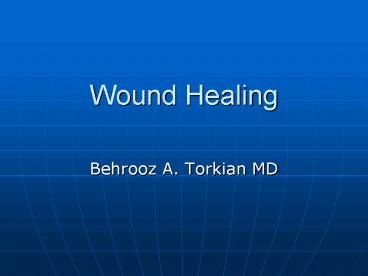Wound Healing - PowerPoint PPT Presentation
1 / 26
Title:
Wound Healing
Description:
Initial vasoconstriction (5-10 min) then vasodilation (persistent) ... Silvia Wagner, PhD et. al. Comparison of inflammatory and systemic sources of ... – PowerPoint PPT presentation
Number of Views:361
Avg rating:3.0/5.0
Title: Wound Healing
1
Wound Healing
- Behrooz A. Torkian MD
2
Introduction
- Basis of repair of tissues
- Enables surgical treatment
- May take advantage for our benefit
- Complications
- Modification and Enhancement
3
Phases of Wound Healing
1. Vascular and inflammatory phase2.
Reepithelization3. Granulation tissue
formation4. Fibroplasia and matrix formation5.
Wound contraction6. Neovascularization7. Matrix
and collagen remodelling
4
Vascular
- Initial vasoconstriction (5-10 min) then
vasodilation (persistent) - Exposure of subendothelial von Willebrand /
factor VII, and fibrillar collagen platelet
plug - Hageman factor (XII) initiation of clotting
cascade and fibrin clot formation
5
Clotting Cascade
6
Inflammatory
- Platelets
- derived growth factor (PDGF), proteases and
vasoactive substances such as serotonin and
histamine - Polymorphonuclear leukocytes
- Macrophages (replace PMNs after 5 days)
- Fibroblasts (recruited by chemotactic factors
released by the above cells)
7
Reepithelization
- Migration (wound edges, hair follicles, adnexa)
- Proliferation (48-72 hours)
- Sutured wounds have a layer of keratinocytes
within 24-48 hours
8
Keratinocytes
- Fibronectin
- Cross links to fibrin matrix/scaffold for
keratinocyte adhesion and migration - Functions as an early component of the
extracellular matrix. - Binds to collagen and interacts with matrix
glycosaminoglycans. - Has chemotactic properties for macrophages,
fibroblasts and endothelial and epidermal cells. - Promotes opsonization and phagocytosis.
- Forms a component of the fibronexus.
- Forms scaffolding for collagen deposition
- Collagenases and neutral proteases debridement
- Plasminogen activator clot dissolution
- Type V collagen
- Requires moisture for epithelial migration
9
Granulation
- Highly vascular network of glycoproteins,
collagen and glycosaminoglycans - Fibroblasts
- collagen
- Elastin
- Fibronectin
- Sulfated and non-sulfated Glycosaminoglycans
- Proteases
- Inflammatory cells
10
Fibroplasia
- Fibroblasts
- Mainly Type III collagen first
- Replaced by type I and II collagen
- Hydroxylation of proline and lysine
- Iron, copper, vitamin C
- Crosslinkage
11
Contraction
- Myofibroblasts
- Fibronexus (Singer)
- Connections between intracellular actin
microfilaments and extracellular collagen,
fibronectin, and between myofibroblasts - Transmits force along entire network
- Centripetal contraction
12
Neovascularization
- Fibronectin
- Macrophage derived angiogenic factor
- Endothelial migration
13
Wound Remodeling
- Increased tensile strength
- Decreased bulk, and erythema
- Replacement of fibronectin by collagen
- Dehydration
- Promotes further crosslinkage of collagen
- Reorientation of collagen to parallel skin
collagen.
14
(No Transcript)
15
(No Transcript)
16
Local Factors
- Infection
- Technique (wound edge ischemia)
- Hematoma
- Foreign body reaction
- Tissue ischemia
- Topical medications and dressings
17
Systemic Factors
- Deficiency states
- Insulin
- Protein (nitrogen balance)
- Vitamins
- A slower re-epithelization
- C Collagen
- K clot formation
- Trace minerals and elements
- Zinc, copper, iron, manganese
18
Systemic Factors
- Medications
- Glucocorticoids
- Anticoagulants
- Antineoplastic drugs
- Cyclosporin A
- Colchicine
- Penicillamine
- Zinc sulfate (high doses)
- Beta amino proprionitrile
19
Growth Factors
- Epidermal growth factor
- Macrophage derived growth factor (MDGF)
- Platelet derived growth factor (PDGF)
- Thrombin
- Insulin
- Lymphokines
20
(No Transcript)
21
Plasminogen activator inhibitor -1
- Found to be elevated in Keloid scars
- PAI-1 -/- knockout mice show accelerated wound
healing after cutaneous injury - PAI-1 seems to regulate fibrinolytic and
proteolytic activity during the replacement of
fibrin by collagen. - PAI-1 is upregulated in cultured fibroblasts in
a hypoxic environment
22
Metalloproteinases Tissue Inhibitor of
Metalloproteinases
- Regulatory role in fibroblasia and scarring
- Found in high concentrations in fetal wounds
- MMP/TIMP is higher in scarless fetal wounds
- TGF-beta decreased the MMP/TIMP ratio by
increasing TIMP - May promote more rapid epithelization
23
TGF Beta-1
- Higher concentrations and exaggerated response in
keloid fibroblasts - When added to fetal wounds thicker scars made.
24
(No Transcript)
25
Silicone
- Decreases TGF-Beta-2, and contraction of
RAFT-fibroblast cultures (Kuhn et. al.) - Increased bFGF levels in cultured fibroblasts
(HanasonoKoch) - Anecdotal evidence
26
References
- Silvia Wagner, PhD et. al. Comparison of
inflammatory and systemic sources of growth
factors in acute and chronic human wounds, Wound
Repair and Regeneration Volume 11 Issue 4 Page
253 - July 2003 doi10.1046/j.1524-475X.2003.1140
4.x - Deodhar AK, Rana RE. Surgical physiology of wound
healing a review. J Postgrad Med serial online
1997 4352-6 http//www.jpgmonline.com/article.as
p?issn0022-3859year1997volume43issue2spage
52epage6aulastDeodhar - Ziv PM et. al., Matrix Metalloproteinases and the
ontogeny of scarless repair the other side of
the wound healing balance, Plastic and
Reconstructive Surgery 110(3)801-11 2002 - Bullard KM et. al. Fetal wound healing Current
Biology, World J. Surg 27 54-61, 2003 - Singer AJ, Clark RAF, Cutaneous Wound Healing,
NEJM 341(10) 738-46 2001 - Saulis AS, Mogford JH, Mustoe TA.Related
Articles, Links Effect of Mederma on
hypertrophic scarring in the rabbit ear
model.Plast Reconstr Surg. 2002
Jul110(1)177-83 discussion 184-6. - Hanasono MM, Lum J, Carroll LA, Mikulec AA, Koch
RJ.Related Articles, Links The effect of
silicone gel on basic fibroblast growth factor
levels in fibroblast cell culture.Arch Facial
Plast Surg. 2004 Mar-Apr6(2)88-93.































